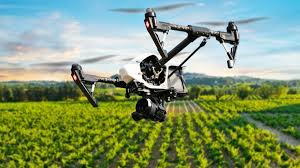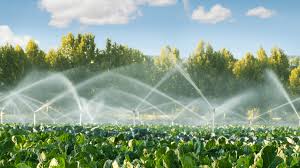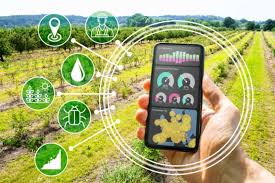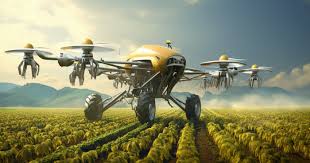Innovative technologies in agriculture are transforming how food is produced, processed, and distributed, addressing the pressing challenges of a growing global population and the increasing demand for sustainable practices.
As traditional farming methods face limitations due to climate change, resource scarcity, and urbanization, these advancements offer practical solutions to enhance productivity and environmental stewardship.
At the forefront of these innovations is precision agriculture, which leverages data analytics, satellite imagery, and IoT devices to optimize farming operations.
By closely monitoring soil health, crop growth, and weather patterns, farmers can make informed decisions about irrigation, fertilization, and pest management. This targeted approach reduces waste and maximizes yields, making it crucial for modern agricultural practices.
Drones and automation technologies further enhance efficiency in the field. Drones can quickly survey large areas, providing valuable insights into crop health and enabling precise interventions. Meanwhile, automated machinery streamlines tasks such as planting and harvesting, significantly reducing labor costs and time.
Biotechnology also plays a critical role in developing resilient crops. Genetically modified organisms (GMOs) can withstand pests, diseases, and extreme weather conditions, ensuring food security in unpredictable climates.
Additionally, innovative methods like vertical farming and hydroponics allow for food production in urban environments, reducing transportation needs and promoting local food systems.
Innovative technologies in agriculture are essential for addressing the complexities of food production today. By integrating these advancements, farmers can increase efficiency, improve sustainability, and contribute to a secure food future, ultimately benefiting both society and the environment.
The Role of Precision Agriculture
Precision agriculture refers to the use of technology to monitor and manage field variability in crops. It utilizes various tools and techniques to gather data and optimize inputs, resulting in improved efficiency and productivity. Key aspects of precision agriculture include:
1. Data Collection: Farmers collect data from various sources, including satellite imagery, sensors, and drones, to assess soil health, crop health, and weather conditions.
2. GPS Technology: Global Positioning System (GPS) technology allows farmers to accurately map and analyze their fields, enabling targeted interventions and reducing waste.
3. Variable Rate Technology (VRT): This technology allows farmers to apply inputs such as fertilizers and pesticides at variable rates based on specific field conditions, optimizing resource use and minimizing environmental impact.
4. Crop Monitoring: Precision agriculture enables real-time monitoring of crop conditions, allowing farmers to identify problems early and take corrective actions.
5. Improved Decision-Making: By utilizing data-driven insights, farmers can make informed decisions about planting, fertilization, irrigation, and pest management.
Benefits of Drones in Farming

Drones have emerged as a powerful tool in modern agriculture, offering numerous benefits:
1. Aerial Imaging: Drones equipped with high-resolution cameras can capture detailed images of fields, helping farmers monitor crop health and detect issues such as pests or diseases.
2. Crop Mapping: Drones can create precise maps of agricultural fields, enabling farmers to analyze crop performance and variability.
3. Field Monitoring: Drones can cover large areas quickly, allowing farmers to monitor crop progress and assess irrigation needs more efficiently than traditional methods.
4. Precision Spraying: Drones can be used for targeted spraying of fertilizers and pesticides, reducing chemical use and minimizing environmental impact.
5. Cost-Effective Solutions: Using drones can save time and labor costs while providing valuable data to improve farming practices.
The Impact of Artificial Intelligence on Crop Management
Artificial Intelligence (AI) is increasingly playing a vital role in agriculture, enhancing crop management practices. Key contributions of AI include:
1. Predictive Analytics: AI algorithms can analyze historical data to predict crop yields, helping farmers plan their planting and harvesting schedules more effectively.
2. Crop Health Monitoring: AI-powered tools can assess crop health by analyzing images from drones or satellites, identifying issues such as nutrient deficiencies or disease outbreaks.
3. Automated Decision-Making: AI can automate decision-making processes, such as irrigation scheduling and pest management, based on real-time data.
4. Customized Recommendations: AI can provide personalized recommendations to farmers based on specific field conditions, improving the efficiency of inputs and resources.
5. Labor Optimization: By automating routine tasks, AI can free up labor for more complex and strategic activities in the farming process.
Read Also: The Common Flagellated Protozoans that Infest Fishes
Smart Irrigation Systems: Conserving Water and Boosting Yields

Water management is crucial for sustainable agriculture, and smart irrigation systems offer effective solutions. These systems utilize technology to optimize water usage, ensuring crops receive the right amount of moisture while conserving resources. Key features include:
1. Soil Moisture Sensors: These sensors monitor soil moisture levels and provide real-time data to inform irrigation schedules, preventing over- or under-watering.
2. Weather Forecast Integration: Smart irrigation systems can integrate weather data to adjust irrigation schedules based on rainfall forecasts, reducing water waste.
3. Automated Irrigation: These systems can be programmed to irrigate crops automatically, ensuring consistent moisture levels and reducing labor costs.
4. Drip Irrigation: Smart irrigation often incorporates drip systems, delivering water directly to the root zone of plants, minimizing evaporation and runoff.
5. Increased Yields: By optimizing water usage, smart irrigation systems can enhance crop yields while promoting water conservation and sustainability.
Genetic Engineering and Biotechnology in Crop Development
Genetic engineering and biotechnology have revolutionized crop development by enabling scientists to modify plants at the genetic level. This process enhances desirable traits, contributing to improved yields, disease resistance, and nutritional quality. Key aspects include:
1. Enhanced Crop Traits: Genetic engineering allows for the development of crops with specific traits, such as drought tolerance, pest resistance, and improved nutritional content. For example, Golden Rice has been engineered to contain higher levels of vitamin A, addressing nutrient deficiencies in many populations.
2. Faster Breeding Cycles: Traditional breeding methods can be time-consuming. Genetic engineering accelerates the development of new varieties by directly altering the genetic material, significantly reducing the time from concept to market.
3. Disease Resistance: Crops can be engineered to resist diseases, reducing the need for chemical pesticides. This not only helps in sustainable farming but also minimizes the environmental impact associated with pesticide use.
4. Stress Tolerance: Biotechnology plays a vital role in developing crops that can withstand abiotic stresses such as drought, salinity, and extreme temperatures, ensuring food security in changing climates.
5. Increased Yield Potential: By improving traits that contribute to growth and productivity, genetically engineered crops can significantly increase agricultural output, helping to feed a growing global population.
Automation and Robotics in Farming Operations
Automation and robotics are streamlining farming operations, increasing efficiency and reducing labor costs. Here are some key benefits:
1. Precision Planting: Automated planting systems ensure seeds are planted at the optimal depth and spacing, improving crop establishment and reducing seed waste.
2. Harvesting Robots: Robotics technology is being employed in harvesting tasks, particularly for fruits and vegetables. These robots can operate continuously, increasing harvesting efficiency and minimizing labor requirements.
3. Soil Monitoring: Automated sensors can monitor soil conditions, such as moisture and nutrient levels, providing real-time data to farmers for informed decision-making.
4. Pest Control: Robotic systems equipped with sensors can identify and target pests, applying pesticides precisely where needed and reducing chemical usage.
5. Labor Efficiency: Automation reduces the reliance on manual labor, which is particularly important in regions facing labor shortages. This helps maintain productivity while ensuring that farming operations run smoothly.
Read Also: The Most Lucrative between Production of Fish Fingerlings or Raising them to Table Size
The Use of Internet of Things (IoT) in Agriculture

The Internet of Things (IoT) is revolutionizing agriculture by connecting devices and systems for better data collection and analysis. Key applications include:
1. Smart Sensors: IoT-enabled sensors monitor various environmental factors such as soil moisture, temperature, and humidity. This data helps farmers optimize irrigation and manage crop health more effectively.
2. Remote Monitoring: Farmers can remotely monitor their fields using IoT devices, allowing them to make real-time decisions without being physically present on-site.
3. Predictive Analytics: IoT data can be analyzed to predict crop yields, pest outbreaks, and disease pressures, enabling proactive management strategies.
4. Resource Management: IoT technology aids in efficient resource management by tracking water usage, fertilizer application, and other inputs, ensuring they are used optimally.
5. Increased Productivity: By utilizing IoT technologies, farmers can increase productivity and reduce operational costs through better decision-making and resource allocation.
Vertical Farming: Maximizing Space and Resources
Vertical farming is an innovative approach to agriculture that maximizes space by growing crops in stacked layers. This method offers several advantages:
1. Space Efficiency: Vertical farming allows for crop production in urban areas where space is limited, making it an ideal solution for growing food in densely populated regions.
2. Reduced Water Usage: Vertical farms often utilize hydroponic or aeroponic systems, which use significantly less water than traditional soil-based farming methods.
3. Year-Round Production: Controlled environments in vertical farms enable year-round crop production, ensuring a consistent supply of fresh produce regardless of external weather conditions.
4. Reduced Transportation Costs: By situating farms closer to urban centers, vertical farming reduces the distance food must travel, decreasing transportation costs and emissions.
5. Sustainable Practices: Vertical farms can incorporate renewable energy sources and waste recycling systems, making them a sustainable alternative to conventional agriculture.
Sustainable Practices: Innovations in Organic Farming
Organic farming focuses on sustainable practices that enhance soil health and promote biodiversity. Key innovations include:
1. Crop Rotation: Practicing crop rotation helps improve soil health, reduce pest and disease pressure, and increase crop yields. By alternating crops, farmers can maintain soil fertility and minimize nutrient depletion.
2. Organic Fertilizers: The use of organic fertilizers, such as compost and manure, enhances soil structure and provides essential nutrients while reducing dependence on synthetic fertilizers.
3. Integrated Pest Management (IPM): IPM combines biological, cultural, and chemical practices to manage pests sustainably. By utilizing natural predators and resistant crop varieties, farmers can reduce reliance on harmful pesticides.
4. Agroecological Practices: Agroecology promotes ecological farming practices that enhance biodiversity and ecosystem health. This includes intercropping, cover cropping, and utilizing natural resources sustainably.
5. Certification and Standards: Innovations in organic farming often involve developing and adhering to strict certification standards, ensuring that products meet consumer expectations for organic quality and sustainability.
Blockchain Technology for Supply Chain Transparency
Blockchain technology is a decentralized digital ledger that records transactions across multiple computers in a way that ensures security and transparency. In agriculture, blockchain offers numerous benefits for supply chain management:
1. Enhanced Traceability: Blockchain allows for real-time tracking of agricultural products from farm to fork. Each transaction is recorded on the blockchain, providing a transparent and immutable record of the product’s journey. This helps consumers know where their food comes from and increases trust in the food system.
2. Improved Food Safety: In the event of a food safety issue, blockchain technology enables quick identification of the source of contamination. This can help prevent widespread outbreaks and reduce food recalls, protecting both consumers and producers.
3. Reduced Fraud: Blockchain can help combat food fraud by verifying the authenticity of products. For instance, it can confirm whether a product is truly organic or whether it meets certain quality standards, thus protecting both consumers and honest producers.
4. Efficient Transactions: Smart contracts, a feature of blockchain, automate and streamline transactions between producers, distributors, and retailers. This reduces the need for intermediaries, leading to lower costs and faster payment processes.
5. Empowering Farmers: By providing a transparent record of their products, farmers can negotiate better prices and build direct relationships with consumers, thus improving their livelihoods.
Soil Health Monitoring with Advanced Sensors
Soil health is critical for sustainable agriculture, and advanced sensors are revolutionizing how farmers monitor and manage soil conditions. Here’s how they work:
1. Real-Time Data Collection: Advanced sensors measure various soil parameters, such as moisture levels, pH, temperature, and nutrient content in real time. This data helps farmers make informed decisions about irrigation, fertilization, and crop selection.
2. Precision Agriculture: By integrating soil sensor data with GPS technology, farmers can practice precision agriculture. This approach allows for site-specific management of inputs, optimizing resource use and improving crop yields.
3. Early Detection of Problems: Continuous monitoring of soil health helps farmers identify issues such as nutrient deficiencies or soil degradation early. This allows for timely interventions, minimizing crop losses and maintaining soil fertility.
4. Data-Driven Decision Making: Advanced sensors provide farmers with the data needed to analyze trends over time. This information can guide long-term strategies for soil management, ensuring sustainable farming practices.
5. Environmental Benefits: Monitoring soil health can also have positive environmental impacts. By using data to apply fertilizers and pesticides more accurately, farmers can reduce chemical runoff and protect nearby ecosystems.
Climate-Smart Agriculture Technologies
Climate-smart agriculture (CSA) aims to increase productivity while adapting to and mitigating climate change. Here are some key technologies in this area:
1. Crop Variety Improvement: CSA promotes the use of climate-resilient crop varieties that can withstand extreme weather conditions, such as droughts or floods. These varieties are developed through traditional breeding methods or biotechnology.
2. Smart Irrigation Systems: Technologies like drip irrigation and moisture sensors allow farmers to optimize water usage. By delivering water directly to the plant’s root zone, these systems minimize waste and reduce water stress during dry periods.
3. Agroforestry: Integrating trees and shrubs into farming systems can enhance biodiversity, improve soil health, and sequester carbon. Agroforestry systems can provide additional income through timber and fruit production while offering protection against climate impacts.
4. Climate-Smart Practices: Practices such as cover cropping, crop rotation, and conservation tillage enhance soil health, improve water retention, and reduce greenhouse gas emissions. These practices contribute to more sustainable agricultural systems.
5. Climate Information Services: Access to accurate climate data and forecasts helps farmers make informed decisions regarding planting and harvesting. Mobile apps and digital platforms provide timely information on weather patterns, pest outbreaks, and disease risks.
6. Renewable Energy Sources: Implementing solar panels and wind turbines in farming operations can reduce reliance on fossil fuels, lower energy costs, and decrease the carbon footprint of agricultural practices.
Do you have any questions, suggestions, or contributions? If so, please feel free to use the comment box below to share your thoughts. We also encourage you to kindly share this information with others who might benefit from it. Since we can’t reach everyone at once, we truly appreciate your help in spreading the word. Thank you so much for your support and for sharing!
Read Also: Complete List of Anti-Inflammatory Foods you Should Know About






